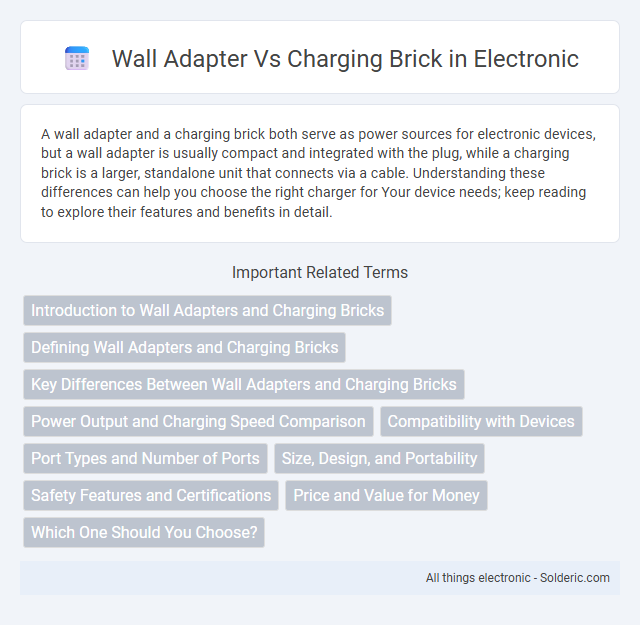A wall adapter and a charging brick both serve as power sources for electronic devices, but a wall adapter is usually compact and integrated with the plug, while a charging brick is a larger, standalone unit that connects via a cable. Understanding these differences can help you choose the right charger for Your device needs; keep reading to explore their features and benefits in detail.
Comparison Table
| Feature | Wall Adapter | Charging Brick |
|---|---|---|
| Definition | Small plug-in device that converts AC power to DC for charging | Larger external power supply that regulates voltage and current for charging |
| Size | Compact and lightweight | Bulkier and heavier |
| Use Case | Ideal for smartphones, tablets, and travel | Common for laptops and high-power devices |
| Power Output | Typically lower wattage (5W-30W) | Higher wattage (30W-100W+) |
| Portability | Highly portable | Less portable due to size |
| Charging Speed | Slower compared to high-powered bricks | Faster charging especially for larger devices |
| Compatibility | Mostly USB-based devices | Varies, includes proprietary and universal adapters |
Introduction to Wall Adapters and Charging Bricks
Wall adapters and charging bricks are essential components for powering electronic devices by converting AC power from outlets into usable DC power. Wall adapters are often integrated into a single compact unit designed for direct plug-in, while charging bricks tend to be larger, external power supplies typically used with various devices like laptops. Understanding the differences in size, functionality, and compatibility helps you choose the right power solution for your electronics.
Defining Wall Adapters and Charging Bricks
Wall adapters, often referred to as power adapters, convert AC electrical power from a wall outlet into a lower voltage compatible with electronic devices, primarily smartphones and laptops. Charging bricks are a type of wall adapter characterized by their bulky, rectangular form factor that houses the necessary electrical components to provide stable power conversion. Both devices serve the same fundamental function of powering and charging electronics, but charging bricks generally support higher wattage outputs and multiple device compatibility.
Key Differences Between Wall Adapters and Charging Bricks
Wall adapters are compact power supply units designed primarily for low-wattage devices like smartphones and tablets, while charging bricks are larger, higher-powered chargers suited for laptops and other power-hungry electronics. Wall adapters typically offer USB output ports and emphasize portability, whereas charging bricks incorporate advanced circuitry for faster charging and heat management. Understanding these key differences helps you choose the right power solution tailored to your device's specific charging requirements.
Power Output and Charging Speed Comparison
Wall adapters and charging bricks vary significantly in power output, influencing their charging speed. High-power wall adapters typically range from 18W to 100W, enabling faster charging for smartphones and laptops, whereas standard charging bricks often provide 5W to 12W, suitable for basic device needs. Devices compatible with higher wattage adapters experience reduced charging times due to increased current and voltage delivery.
Compatibility with Devices
Wall adapters and charging bricks both function as power sources but differ in compatibility with devices due to their design and power output. Wall adapters typically offer limited USB ports and lower wattage, making them suitable for smartphones and smaller gadgets, whereas charging bricks often provide multiple ports and higher wattage, supporting laptops, tablets, and faster charging for various devices. Device compatibility depends primarily on the adapter's power specifications and connector types, ensuring efficient and safe charging across diverse electronics.
Port Types and Number of Ports
Wall adapters typically feature one or two USB ports, commonly USB-A or USB-C, designed for charging single devices. Charging bricks often offer multiple ports, combining USB-A and USB-C connections to charge several devices simultaneously. The choice between them depends on the required port types and the number of devices needing power at once.
Size, Design, and Portability
Wall adapters tend to be smaller and more compact compared to traditional charging bricks, making them ideal for on-the-go use and easy storage. Their streamlined design often includes built-in plugs that fold, enhancing portability without sacrificing functionality. Choosing a wall adapter can simplify your charging setup by offering a lightweight and space-saving solution for powering devices.
Safety Features and Certifications
Wall adapters and charging bricks both include safety features such as overcurrent protection, short-circuit prevention, and temperature control to prevent overheating. Certified products often meet standards like UL, CE, FCC, or RoHS, ensuring compliance with electrical safety and environmental regulations. Choosing a certified adapter or brick significantly reduces risks like electrical shocks, fire hazards, and device damage.
Price and Value for Money
Wall adapters typically offer a more affordable price point compared to charging bricks, making them a budget-friendly choice for everyday device charging. Charging bricks often provide higher wattage and faster charging capabilities, delivering greater value for money for users with high-power devices. Evaluating price against performance helps consumers select the optimal charger based on their specific needs and device compatibility.
Which One Should You Choose?
Choosing between a wall adapter and a charging brick depends on your device compatibility and charging needs. Wall adapters are typically compact and designed for lower wattage, making them ideal for smartphones and small gadgets, while charging bricks offer higher power output, suitable for laptops and fast charging. Consider your device's power requirements and portability preferences to determine which option best supports your charging routine.
Wall adapter vs Charging brick Infographic

 solderic.com
solderic.com